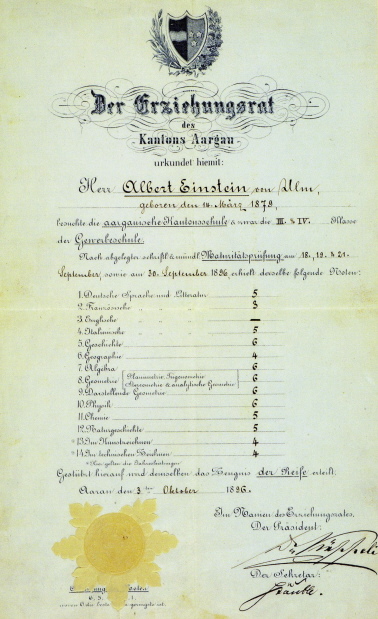“Teaching should be such that what is offered is perceived as a valuable gift
and not as a hard duty.”
Albert Einstein, 1952
ALBERT EINSTEIN’S CERTIFICATE OF QUALIFICATION FOR UNIVERSITY MATRICULATION
At the age of five Albert Einstein got private lessons from a tutor. However, this did not last long as Albert had thrown a chair after his tutor because he was in a bad temper. In the same year he also began to learn the violin. From 1885 when he was six years old he attended “Petersschule”, a catholic elementary school in Munich. Due to a report card from school Albert’s mother wrote to her sister: “Yesterday Albert received his grades, he was again number one, and his report card was brilliant.” In October 1888 he changed to Luitpold grammar school. As he was not able to cope with the authoritarian attitude of the school and as time went by had more and more severe problems with some of his teachers he left grammar school ahead of time in December 1894 without a degree. His class teacher had once said to him that “never will he get anywhere”.
To be able to study at the Swiss Polytechnic (the later ETH) in Zurich also without A-levels, Albert Einstein had to take a college entrance exam in October 1895. His performance in physics and mathematics was excellent. The performances in some of the other tested areas however were not sufficient. Albert Einstein did not pass the exam! Subsequently he followed the advice the director of the Zurich University gave him and went to a school in Aarau (canton of Aargau) in Switzerland in October 1895 to close the gap in his knowledge. In September 1896 he successfully passed his A-levels in written and oral from. In October 1896 he began to study at the Swiss Polytechnic. His ambition was to obtain the diploma of a subject teacher for mathematics and physics. In July 1900 he successfully finished his studies.
The Swiss A-levels are called “Matur”; it corresponds to the German “Abitur”. Furthermore it has to be noticed that the assessment scale for school performance (school grades) in Germany and in Switzerland differs from each other, i.e. the grade 1 (excellent) in Germany equals grade 6 in Switzerland; the grade 2 (good) equals grade 5, etc.

Final Grades, Aargau Kantonsschule:
Certificate of qualification for
university matriculation
Albert Einstein
Aarau, den 3. October 1896
| German language | 5 |
| French language | 3 |
| English language | – |
| Italian language | 5 |
| History | 6 |
| Geography | 4 |
| Algebra | 6 |
| Geometry | 6 |
| Descriptive geometry | 6 |
| Physics | 6 |
| Chemistry | 5 |
| Natural history | 5 |
| Art drawing | 4 |
| Technical drawing | 4 |
Marks: 6 = excellent, 5 = good, 4 = sufficient, 3 = poor, 2 = very poor, 1 = unusable
In the course of his school time Albert Einstein turned to be a very good pupil in mathematics and science. In the other school subjects he was a more “moderate” pupil. Of course this fact had nothing to do with a lack of intelligence. He simply did not want to understand that he should also learn things that did not interest him. In his certificate of qualification for university matriculation the lessons which he was less interested in can easily be detected. But the average grade in his certificate was a 5, i.e. the grade “good”!
The “moderate pupil” Albert Einstein grew to be one of the most important scientists of the 20th century!
Notice: Albert Einstein never “failed” one single class.
07/25
Illustrations Credits:
Public Domain: 1
Bibliography:
| Editors: J. Stachel, a.o. | The Collected Papers of Albert Einstein, Volume 1 | Princeton 1987 |


 DEUTSCH
DEUTSCH